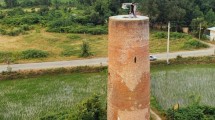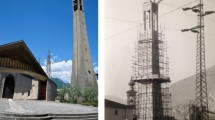Abstract
A theoretical analysis using three well-known masonry analysis constitutive models is performed on a masonry structure to simulate the response of the structure to specific seismic forces. The results of the three numerical approaches are compared and a discussion is presented, mainly intended for professionals, concerning the suitability of the three models and the limitations of each numerical approach. The aim of the study is to evaluate the relative accuracy of the three different models and their suitability for determining the failure mode of the masonry chimney. The models studied are: a linear elastic constitutive model, an elastic-plastic Drucker-Prager’s type model and a model including cracking and/or crushing in the material using Willam-Warnke’s criterion. A macromodelling approach is used because of the great number of elements forming the structure and the computational demand. Seismic actions are synthetically generated and scaled until chimney failure, in accordance with the present regulations on seismic-proof constructions in Europe and Spain. Conclusions for researchers and professionals are obtained to determine the suitability of each model according to the results required and the available calculation capacity.















Similar content being viewed by others
References
Riva G, Zorgno AM (1995) Old brickwork chimneys: structural features and restoration problems. In: 4th International Conference on Structural Studies, Repairs and Maintenance of Historical Buildings, STREMAH ‘95, Comp Mech Publications, Southampton, Boston, vol 2, Dynamics, Repairs &Restoration, 1995, pp 317–327
Pistone G, Riva G, Zorgno AM (1995) Structural behaviour of ancient chimneys. In: 5th Internal Conference on Structural Studies, Repairs and Maintenance of Historical Buildings, STREMAH ‘95, Comp Mech Publications, Southampton, Boston, vol 3, Advances in Architecture Series, 1995, pp 331–341
Pallarés FJ, Agüero A, Martín M (2006) Seismic behaviour of industrial masonry chimneys. Int J Solids Struct 43(7–8):2076–2090
Aoki T, Sabia D (2006) Structural characterization of a brick chimney by experimental tests and numerical model updating. Masonry Int 19(2):41–52
Pallarés FJ (2005) Contribución al análisis sísmico de chimeneas industriales de obra de fábrica mediante el método de los elementos finitos. PhD Thesis (in Spanish). Universidad Politécnica de Valencia
Ghobarah A, Baumber T (1992) Seismic response and retrofit of industrial brick masonry chimneys. Can J Civil Eng 19:117–128
Eurocode 8: Design provisions for earthquake resistance of structures. Part 1-1: general rules. Seismic actions and general requirements for structures
Norma de Construcción Sismorresistente: Parte General y Edificación (NCSE-02) (2002) Ministerio de Fomento, (Spanish Standard)
Zienkiewicz OC, Taylor RL (1991) The finite element method, 4th edn. McGraw-Hill, London
Lourenço PB, Rots JG (1997) Multisurface interface model for analysis of masonry structures. J Eng Mech 123(7):660–668
Lotfi HR, Shing PB (1991) An appraisal of smeared crack models for masonry shear wall analysis. Comput Struct 41(3):413–425
Middleton J, Pande GN, Liang JX, Kralj B (1991) Some recent advances in computer methods in structural masonry. Computer methods in structural masonry. In: Middleton J, Pande GN (eds) Books and Journals International, Swansea, UK, pp 1–21
Genna F, Di Pasqua M, Veroli M, Ronca P (1998) Numerical analysis of old masonry buildings: a comparison among constitutive models. Eng Struct 20(1–2):37–53
Costa A, Arêde A (2006) Strengthening of structures damaged by the Azores earthquake of 1998. Construct Build Mater 20:252–268
Oliveira DV, Lourenço PB (2004) Implementation and validation of a constitutive model for the cyclic behaviour of interface elements. Comput Struct 82:1451–1461
De Castro DV (2002) Experimental and numerical analysis of Blocky masonry structures under cyclic loading. Thesis, Escola de Engenharia, Universidade do Minho
Gouilly A (1876) Théorie sur la Stabilité des Hautes Cheminées en Maçonnerie. J Dejey & Cia Imprimeurs
Esselborn C (1952) Tratado General de Construcción: Parte 1, Construcción de Edificios. Gustavo Gili (ed), Buenos Aires, Argentina
Pallarés FJ, Martín M (2001) Industrial chimneys in Valencia City. Structural response model (in Spanish). VI International Seminar Forum UNESCO, 2001
Gasparini DA, Vanmarcke EH (1976) Simulated earthquake motions compatible with prescribed response spectra. Massachusetts Institute of Technology, Cambridge, Massachusetts
Álvarez A (1904) Manual del Ingeniero. Adrián Romo (ed), Madrid, Spain
Mazzocchi L (1965) Memorial Técnico. Dossat (ed) (in Spanish)
Naraine K, Shina S (1991) Model for cyclic compressive behavior of brick masonry. ACI Struct J 88(5):603–609
Addessi D, Marfia S, Sacco E (2002) A plastic local nondamage model. Comput Methods Appl Mech Eng 191:1291–310
Cerioni R, Brighenti R, Donida G (1995) Use of incompatible displacement modes in a finite element model to analyze the dynamic behavior of unreinforced masonry panels. Comput Struct 57(1):47–57
Kappos AJ, Penelis GG, Drakopoulos CG (2002) Evaluation of simplified models for lateral load analysis of unreinforced masonry buildings. J Struct Eng 128(7):890–897
Dhanasekar M, Page AW, Kleeman PW (1985) The failure of brick masonry under biaxial stresses. Proc ICE (part 2) 79:295–313
Litewka A, Szojda L (2006) Damage, plasticity and failure of ceramics and cementitious composites subjected to multi-axial state of stress. Int J Plast 22:2048–2065
Drucker DC, Prager W (1952) Soil mechanics and plastic analysis or limit design. Q Appl Math 10:157–165
Willam KJ, Warncke ED (1975) Constitutive model for the triaxial behaviour of concrete. Proceedings of the International Association for Bridge and Structural Engineering, 1975, 19. ISMES. Bergamo, Italy
Chen WF, Saleeb AF (1982) Constitutive equations for engineering materials, vol 1. Elasticity and Modeling. John Wiley and Sons
Author information
Authors and Affiliations
Corresponding author
Rights and permissions
About this article
Cite this article
Pallarés, F.J., Agüero, A. & Ivorra, S. A comparison of different failure criteria in a numerical seismic assessment of an industrial brickwork chimney. Mater Struct 42, 213–226 (2009). https://doi.org/10.1617/s11527-008-9379-5
Received:
Accepted:
Published:
Issue Date:
DOI: https://doi.org/10.1617/s11527-008-9379-5




